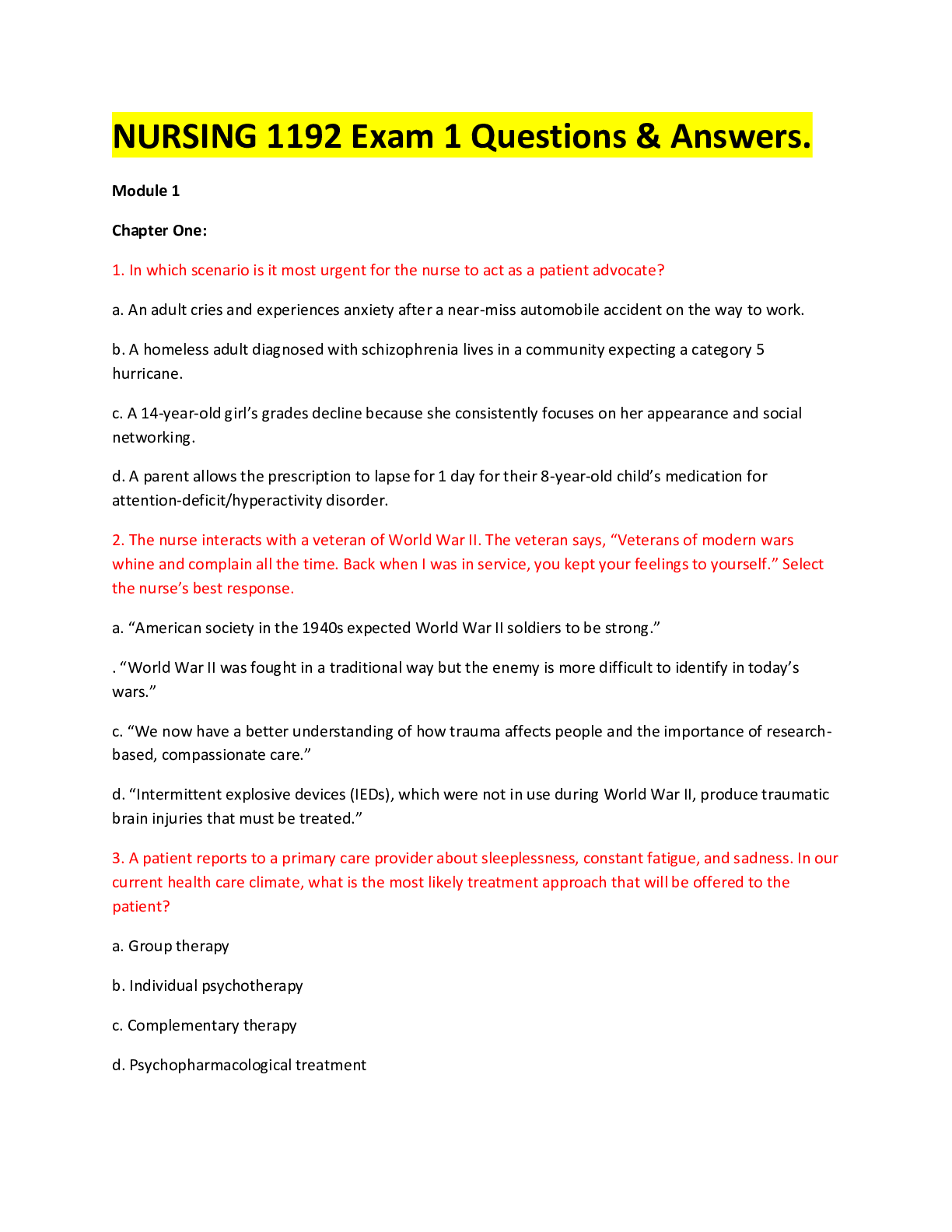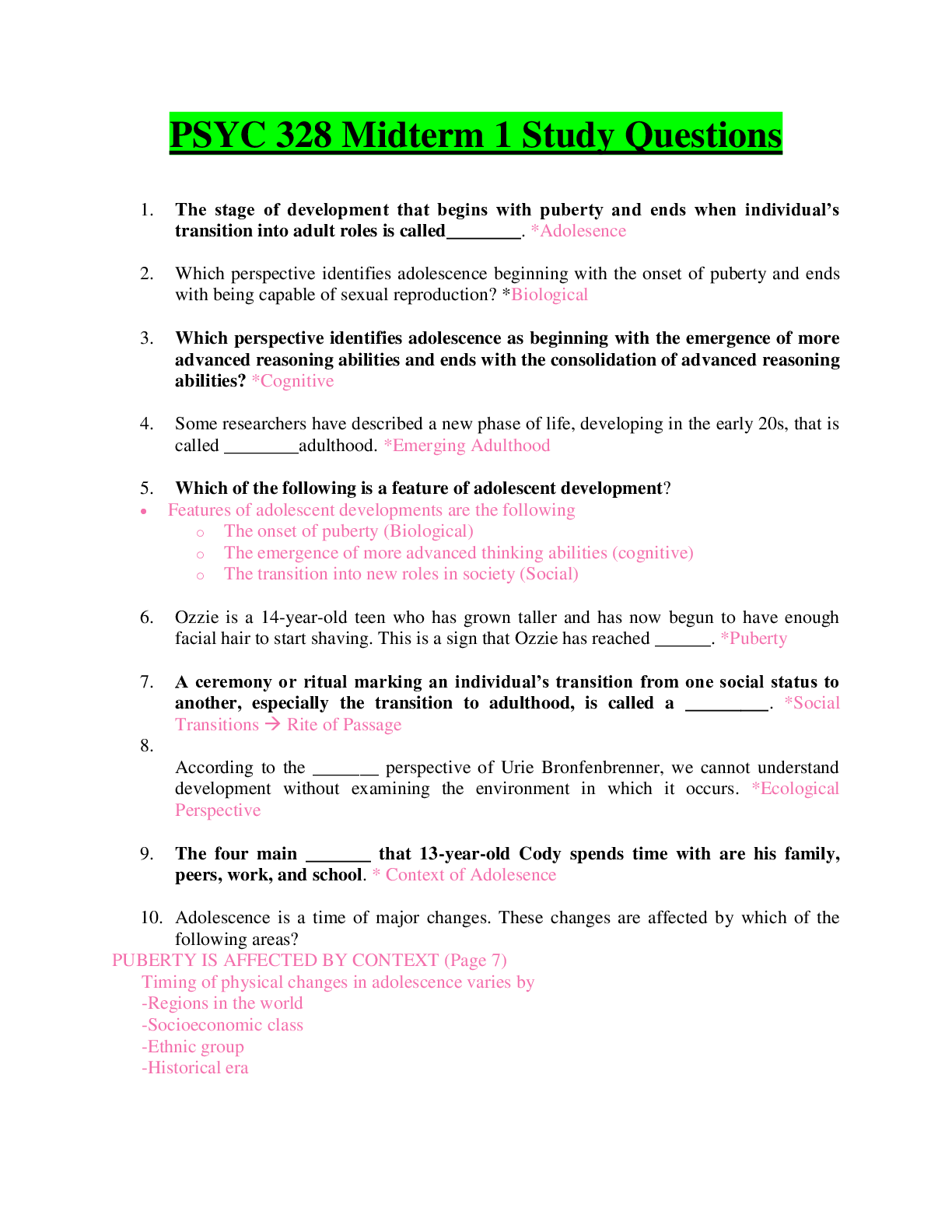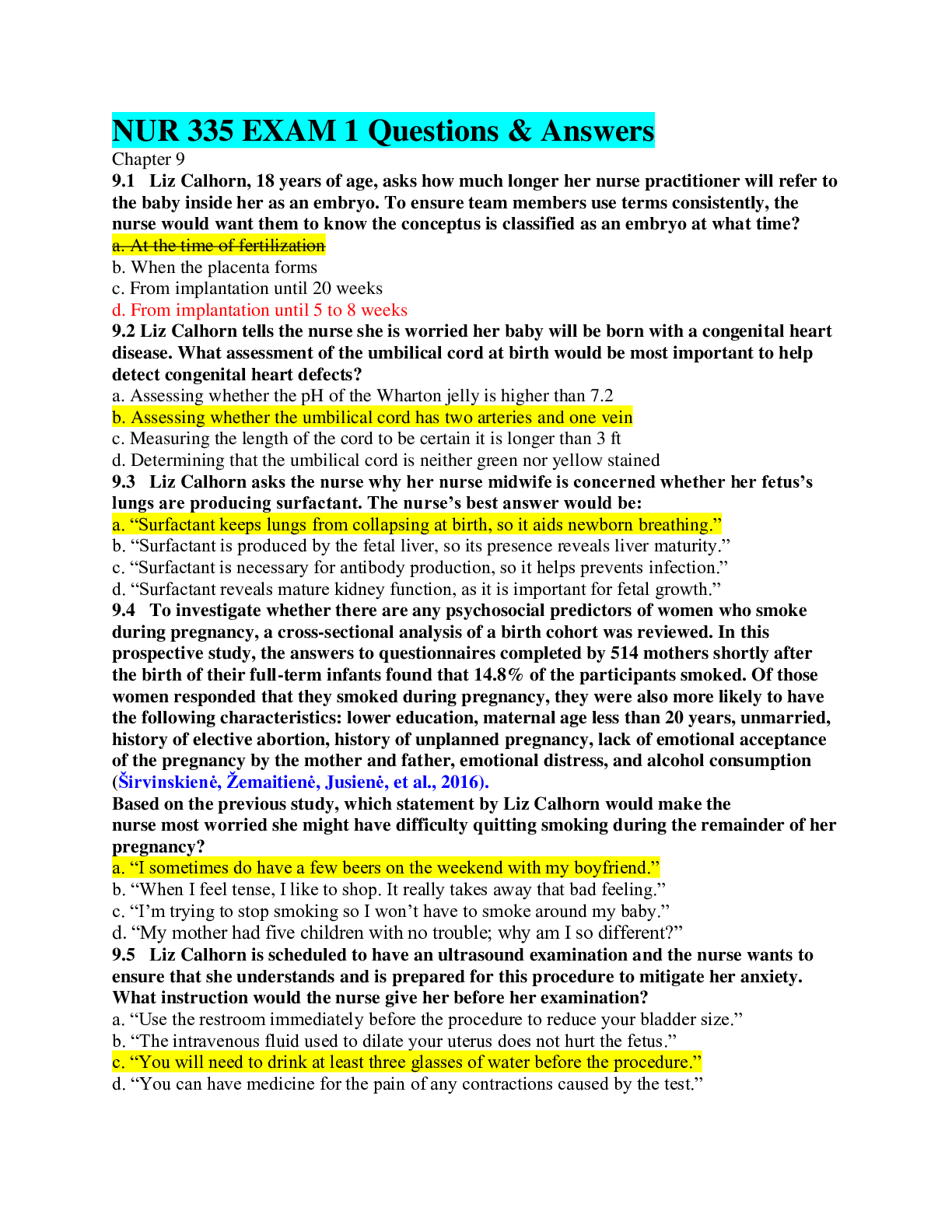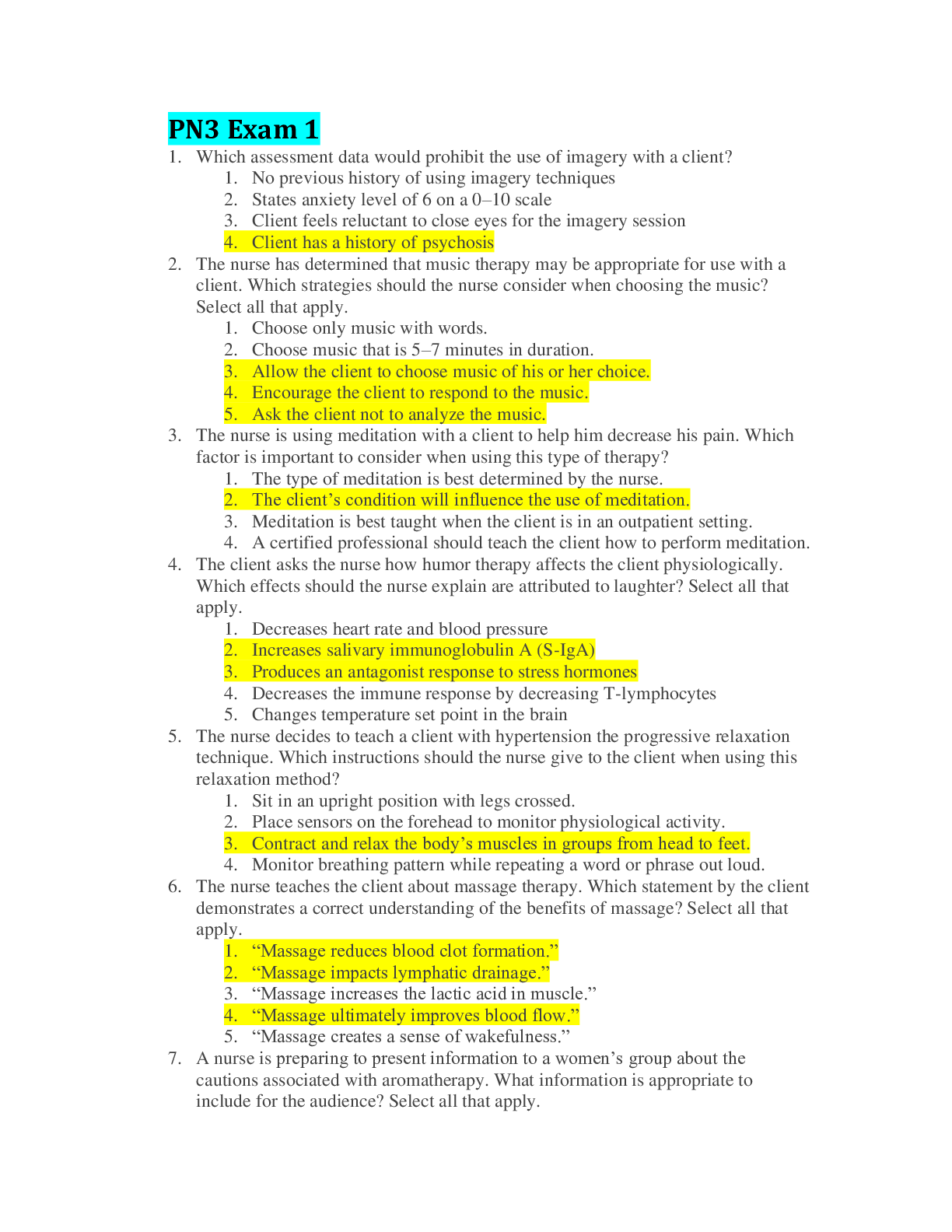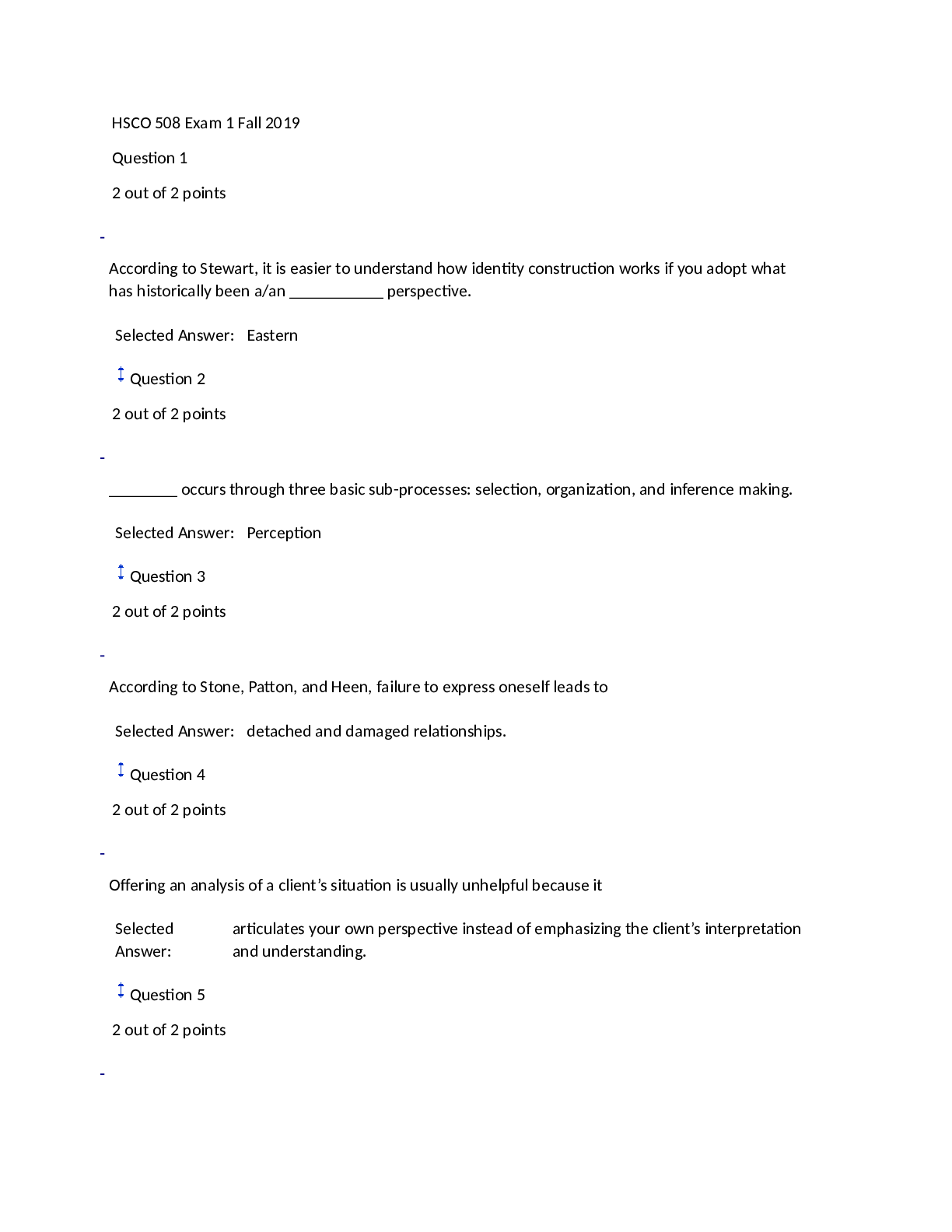Health Care > QUESTIONS & ANSWERS > NUR 405 Exam 1 Questions and Answers 2023/3024 Latest Solved Material (All)
NUR 405 Exam 1 Questions and Answers 2023/3024 Latest Solved Material
Document Content and Description Below
. A nurse is assessing a client who is experiencing occasional feelings of sadness because of the recent death of a beloved pet. The client's appetite, sleep patterns, and daily routine have not chang... ed. How should the nurse interpret the client's behaviors? A. The client's behaviors demonstrate mental illness in the form of depression. B. The client's behaviors are extensive, which indicates the presence of mental illness. C. The client's behaviors are not congruent with cultural norms. D. The client's behaviors demonstrate no functional impairment, indicating no mental illness. - ANS: D The nurse should assess that the client's daily functioning is not impaired. The client who experiences feelings of sadness after the loss of a pet is responding within normal expectations. Without significant impairment, the client's distress does not indicate a mental illness. 2. At what point should the nurse determine that a client is at risk for developing a mental disorder? A. When thoughts, feelings, and behaviors are not reflective of the DSM-5 criteria B. When maladaptive responses to stress are coupled with interference in daily functioning C. When the client communicates significant distress D. When the client uses defense mechanisms as ego protection - ANS: B The nurse should determine that the client is at risk for mental disorder when responses to stress are maladaptive and interfere with daily functioning. The DSM-5 indicates that in order to be diagnosed with a mental disorder, there must be significant disturbance in cognition, emotion, regulation, or behavior that reflects a dysfunction in the psychological, biological or developmental processes underlying mental functioning. These disorders are usually associated with significant distress or disability in social, occupational, or other important activities. The client's ability to communicate distress would be considered a positive attribute 3. A nurse is assessing 15-year-old identical twins who respond very differently to stress. One twin becomes anxious and irritable, while the other withdraws and cries. How should the nurse explain these different responses to stress to the parents? A. Reactions to stress are relative rather than absolute; individual responses to stress vary. B. It is abnormal for identical twins to react differently to similar stressors. C. Identical twins should share the same temperament and respond similarly to stress. D. Environmental influences weigh more heavily than genetic influences on reactions to stress. - ANS: A Responses to stress are variable among individuals and may be influenced by perception, past experience, and environmental factors in addition to genetic factors. 4. A client has a history of excessive drinking, which has led to multiple arrests for driving under the influence (DUI). The client states, "I work hard to provide for my family. I don't see why I can't drink to relax." The nurse recognizes the use of which defense mechanism? A. Projection B. Rationalization C. Regression D. Sublimation - ANS: B The nurse should recognize that the client is using rationalization, a common defense mechanism. The client is attempting to make excuses and create logical reasons to justify unacceptable feelings or behaviors. 5. Which client should the nurse anticipate to be most receptive to psychiatric treatment? A. A Jewish, female journalist B. A Baptist, homeless male C. A Catholic, black male D. A Protestant, Swedish business executive - ANS: A The nurse should anticipate that the client of Jewish culture would place a high importance on preventative health care and would consider mental health as equally important as physical health. Women are also more likely than men to seek treatment for mental health problems. 6. A new psychiatric nurse states, "This client's use of defense mechanisms should be eliminated." Which is a correct evaluation of this nurse's statement? A. Defense mechanisms can be self-protective responses to stress and need not be eliminated. B. Defense mechanisms are a maladaptive attempt of the ego to manage anxiety and should always be eliminated. C. Defense mechanisms, used by individuals with weak ego integrity, should be discouraged and not eliminated. D. Defense mechanisms cause disintegration of the ego and should be fostered and encouraged. - ANS: A The nurse should know that defense mechanisms serve the purpose of reducing anxiety during times of stress. A client with no defense mechanisms may have a lower tolerance for stress, predisposing him or her to anxiety disorders. Defense mechanisms should be confronted when they impede the client from developing healthy coping skills. 7. During an intake assessment, a nurse asks both physiological and psychosocial questions. The client angrily responds, "I'm here for my heart, not my head problems." Which is the nurse's best response? A. "It's just a routine part of our assessment. All clients are asked these same questions." B. "Why are you concerned about these types of questions?" C. "Psychological factors, like excessive stress, have been found to affect medical conditions." D. "We can skip these questions, if you like. It isn't imperative that we complete this section." - ANS: C The nurse should attempt to educate the client on the negative effects of excessive stress on medical conditions. It is not appropriate to skip either physiological or psychosocial questions, as this would lead to an inaccurate assessment. 8. Which statement reflects a student nurse's accurate understanding of the concepts of mental health and mental illness? A. "The concepts are rigid and religiously based." B. "The concepts are multidimensional and culturally defined." C. "The concepts are universal and unchanging." D. "The concepts are unidimensional and fixed." - ANS: B The student nurse should understand that mental health and mental illness are multidimensional and culturally defined. It is important for nurses to be aware of cultural norms when evaluating a client's mental state. 9. A mental health technician asks the nurse, "How do psychiatrists determine which diagnosis to give a patient?" Which of these responses by the nurse would be most accurate? A. Psychiatrists use pre-established criteria from the APA's Diagnostic and Statistical Manual of Mental Disorders (DSM-5). B. Hospital policy dictates how psychiatrists diagnose mental disorders. C. Psychiatrists assess the patient and identify diagnoses based on the patient's unhealthy responses and contributing factors. D. The American Medical Association identifies 10 diagnostic labels that psychiatrists can choose from. - ANS: A The DSM-5 is an organized manual describing mental disorders and the criteria that determine whether a given diagnosis is appropriate. It is published by the American Psychiatric Association (APA). It intends to facilitate accurate and reliable medical diagnosis and treatment. Item C describes nursing rather than medical diagnosis. 10. The nurse is preparing to provide medication instruction for a patient. Which of the following understandings about anxiety will be essential to effective instruction? A. Learning is best when anxiety is moderate to severe. B. Learning is enhanced when anxiety is mild. C. Panic level anxiety helps the nurse teach better. D. Severe anxiety is characterized by intense concentration and enhances the attention span. - ANS: B Mild anxiety sharpens the senses, increases the perceptual field, and results in heightened awareness of the environment. Learning is enhanced. As anxiety increases, attention span decreases and learning becomes more difficult. 11. Which of the following are identified as psychoneurotic responses to severe anxiety as they appear in the DSM-5? A. Somatic symptom disorders B. Grief responses C. Psychosis D. Bipolar disorder - ANS: A Somatic symptom disorder is characterized by preoccupation with physical symptoms for which there is no demonstrable organic pathology. One of the diagnostic criteria is a high level of anxiety about health concerns or illness. 12. An employee uses the defense mechanism of displacement when the boss openly disagrees with suggestions. What behavior would be expected from this employee? A. The employee assertively confronts the boss B. The employee leaves the staff meeting to work out in the gym C. The employee criticizes a coworker D. The employee takes the boss out to lunch - ANS: C The client using the defense mechanism of displacement would criticize a coworker after being confronted by the boss. Displacement refers to transferring feelings from one target to a neutral or less-threatening target. 13. A teenage boy is attracted to a female teacher. Without objective evidence, a school nurse overhears the boy state, "I know she wants me." This statement reflects which defense mechanism? A. Displacement B. Projection C. Rationalization D. Sublimation - ANS: B The nurse should determine that the client's statement reflects the defense mechanism of projection. Projection refers to the attribution of one's unacceptable feelings or impulses to another person. When the client "passes the blame" of the undesirable feelings, anxiety is reduced. Displacement refers to transferring feelings from one target to another. Rationalization refers to making excuses to justify behavior. Sublimation refers to channeling unacceptable drives or impulses into more constructive, acceptable activities. 14. A fourth-grade boy teases and makes jokes about a cute girl in his class. This behavior should be identified by a nurse as indicative of which defense mechanism? A. Displacement B. Projection C. Reaction formation D. Sublimation - ANS: C The nurse should identify that the boy is using reaction formation as a defense mechanism. Reaction formation is the attempt to prevent undesirable thoughts from being expressed by expressing opposite thoughts or behaviors. Displacement refers to transferring feelings from one target to another. Rationalization refers to making excuses to justify behavior. Projection refers to the attribution of unacceptable feelings or behaviors to another person. Sublimation refers to channeling unacceptable drives or impulses into more constructive, acceptable activities. 15. Which nursing statement about the concept of neuroses is most accurate? A. "An individual experiencing neurosis is unaware that he or she is experiencing distress." B. "An individual experiencing neurosis feels helpless to change his or her situation." C. "An individual experiencing neurosis is aware of psychological causes of his or her behavior." D. "An individual experiencing neurosis has a loss of contact with reality." - ANS: B The nurse should understand that the concept of neuroses includes the following characteristics. The client feels helpless to change his or her situation, the client is aware that he or she is experiencing distress, the client is aware the behaviors are maladaptive, the client is unaware of the psychological causes of the distress, and the client experiences no loss of contact with reality [Show More]
Last updated: 2 years ago
Preview 1 out of 21 pages
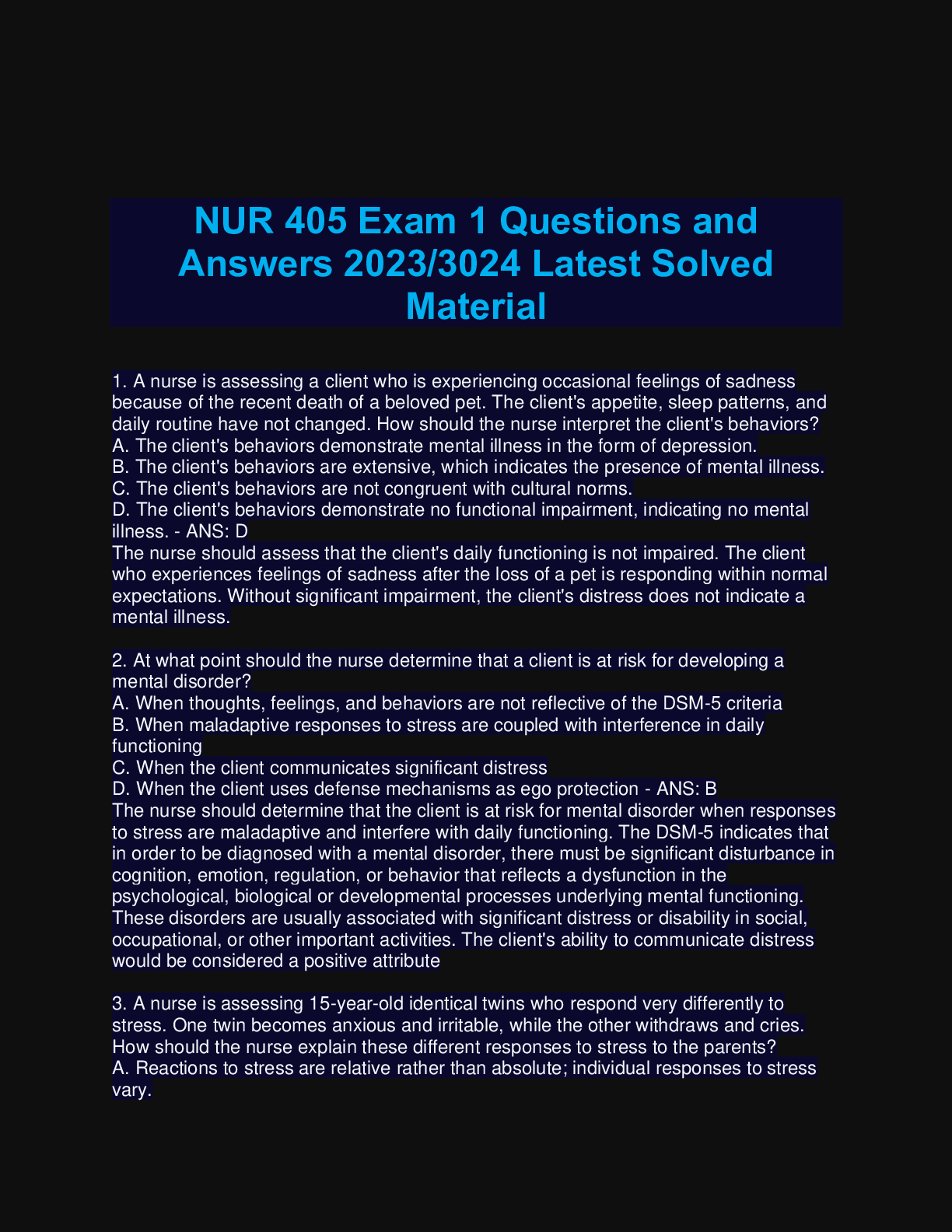
Buy this document to get the full access instantly
Instant Download Access after purchase
Buy NowInstant download
We Accept:

Reviews( 0 )
$8.00
Can't find what you want? Try our AI powered Search
Document information
Connected school, study & course
About the document
Uploaded On
Feb 01, 2023
Number of pages
21
Written in
Additional information
This document has been written for:
Uploaded
Feb 01, 2023
Downloads
0
Views
92


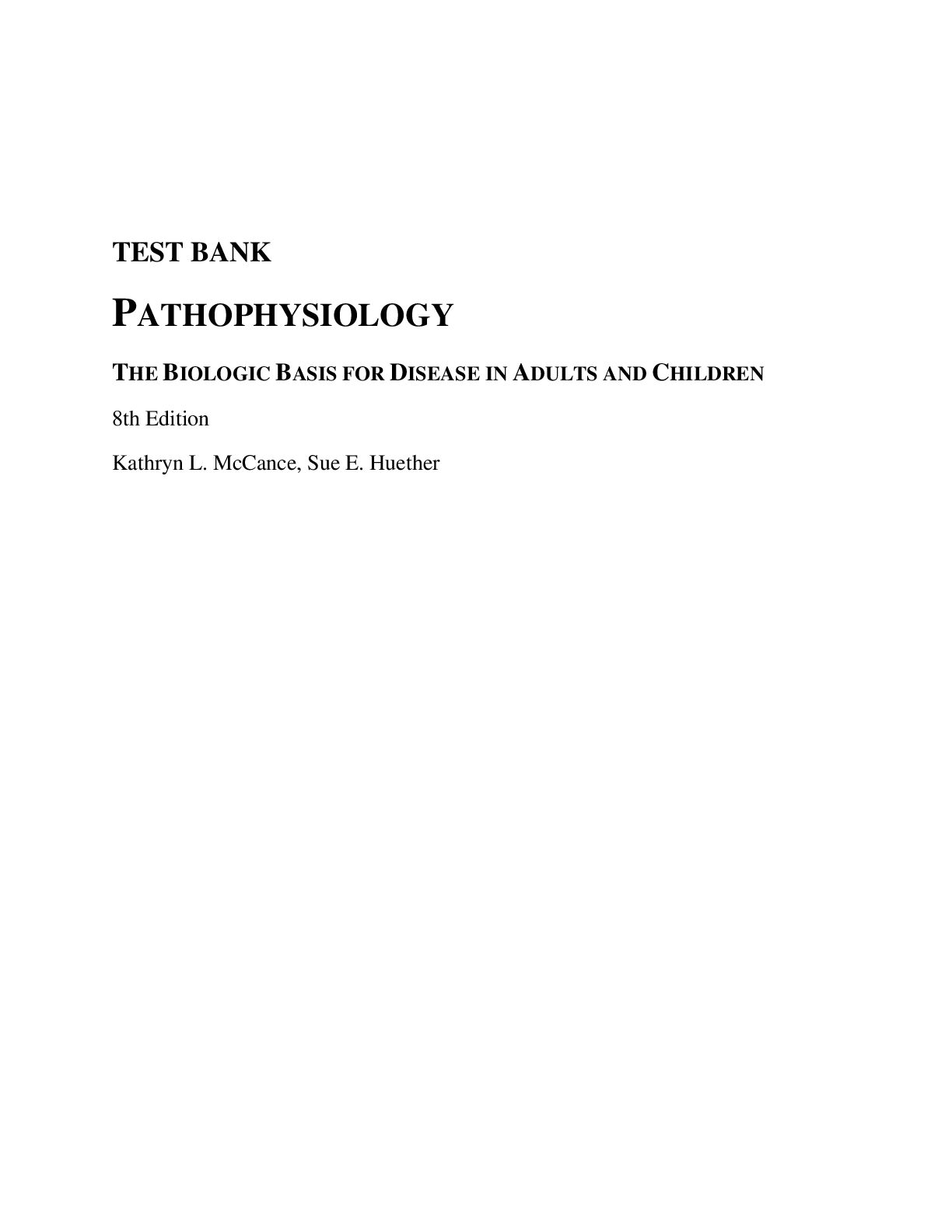


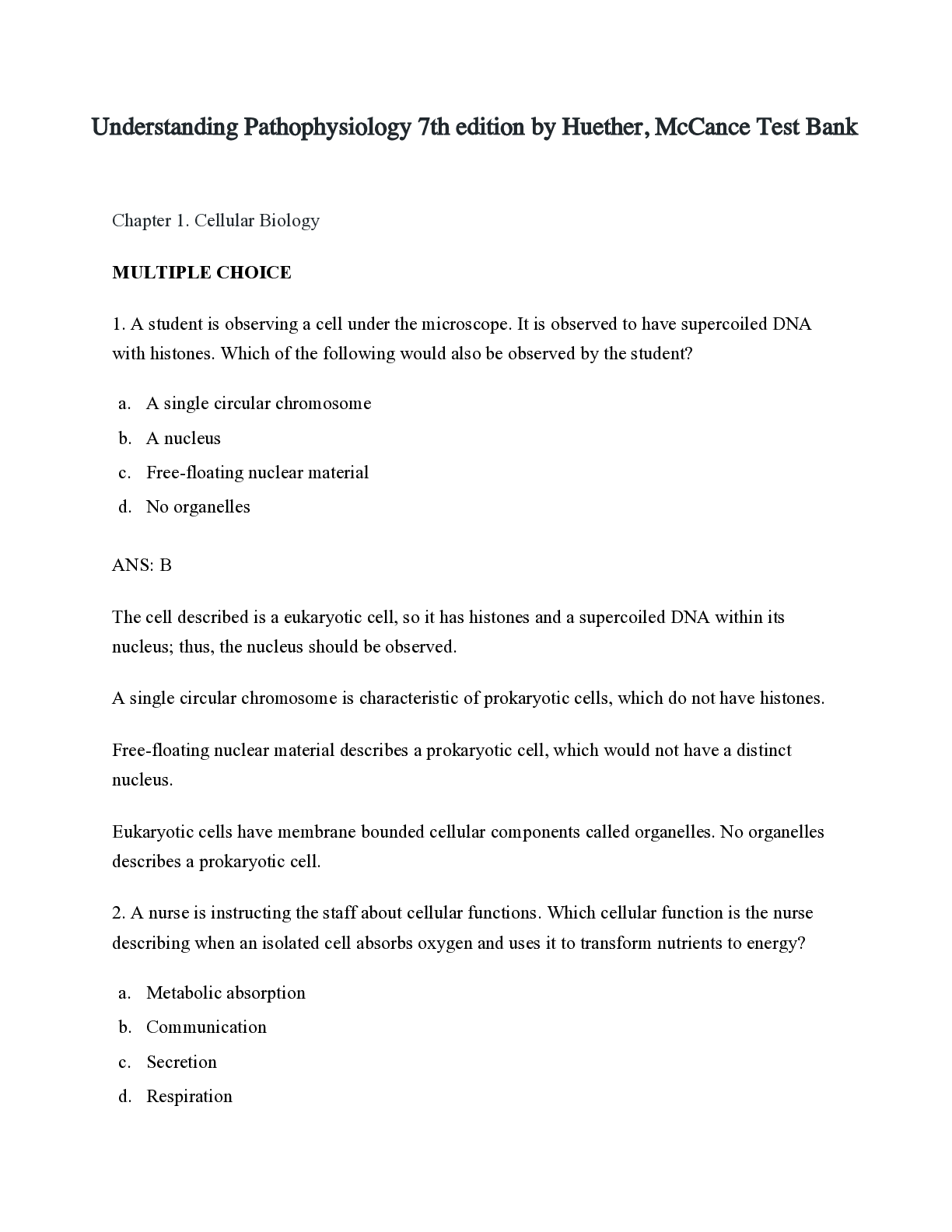
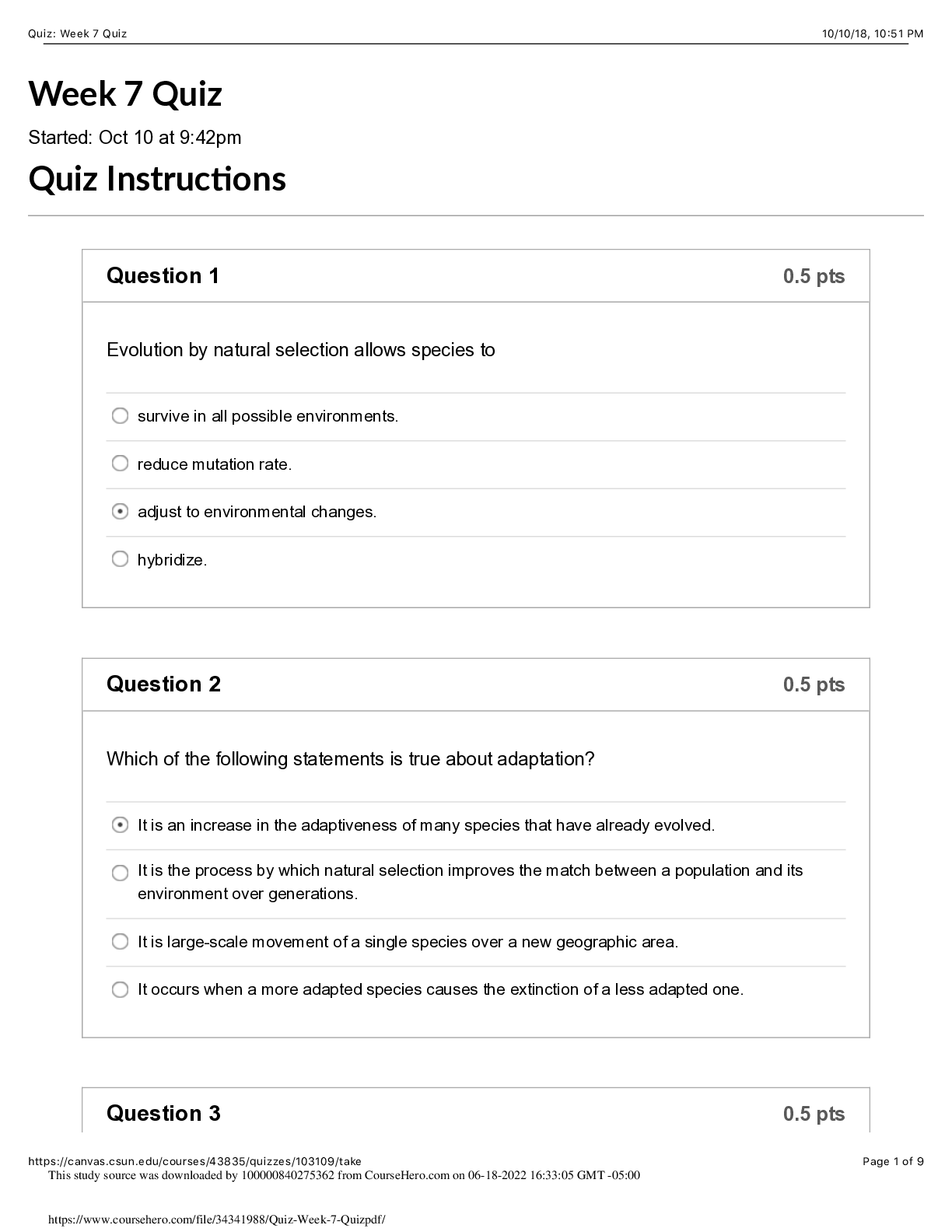
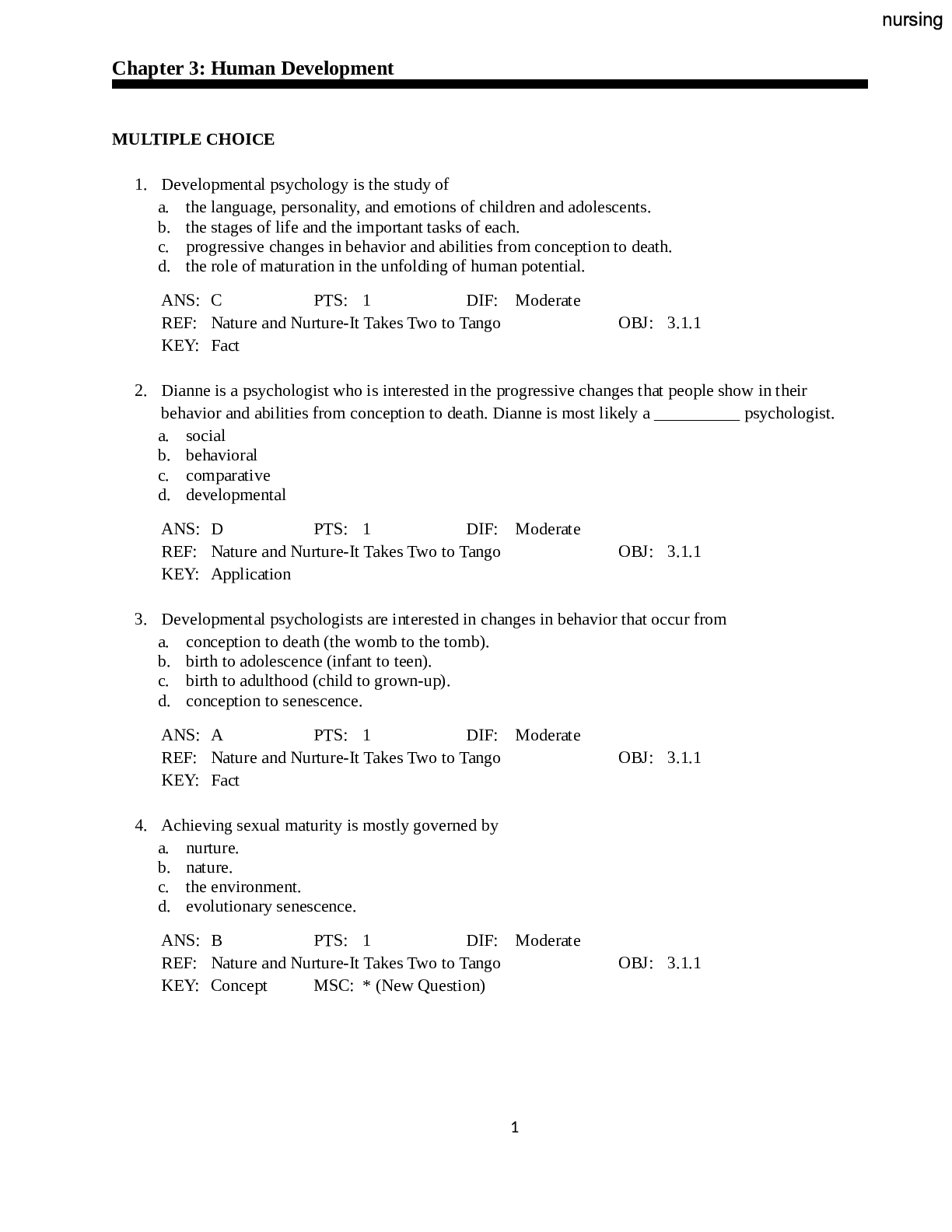

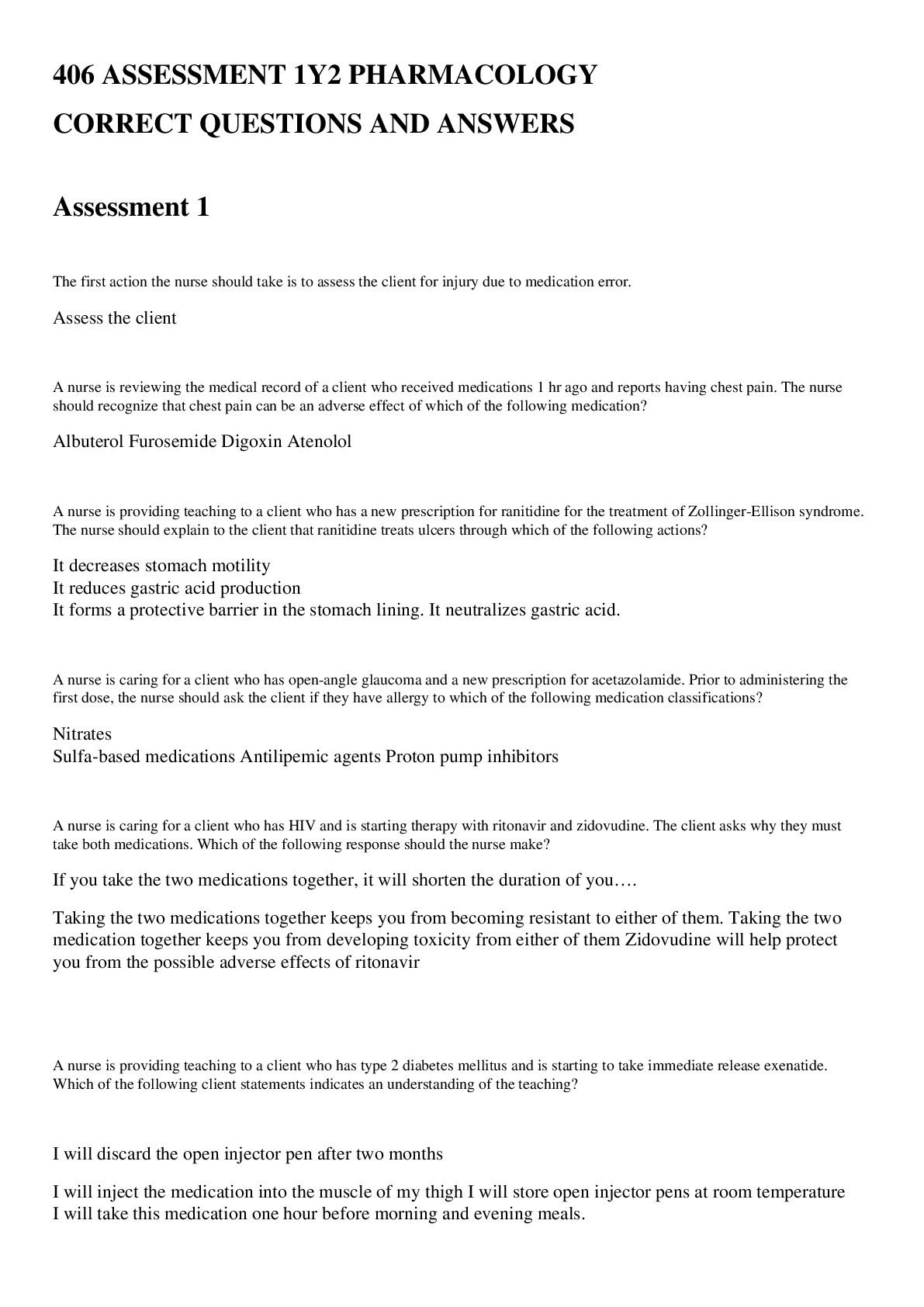
.png)



